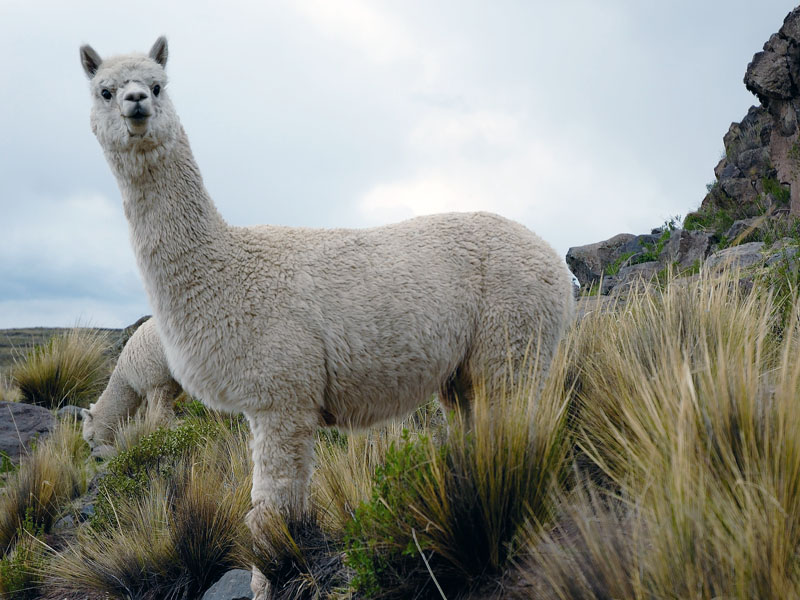Alpaca hair
Variety: Alpaca
Origin of the fibre: The alpaca.
Origin: Peru, Bolivia and Chile.
Characteristics:
- Soft, light and warm natural fibre belonging to the group of noble fibres.
- High resistance.
- Variety of natural colours (white, black, brown, brown, grey or brown).
- Alpaca hair is considered to be one of the finest, ranging in thickness from 18 to 22 microns.
- The fibre is obtained from alpacas, animals fed on pesticide-free grasses and local fodder.
- Produced in a traditional way respecting the animal and the environment.
- Used in the manufacture of clothing and other products.
Alpaca hair is a type of wool obtained from the alpaca, a mammal native to Bolivia, Chile, Argentina, Ecuador and mainly Peru. The latter is considered to be the country with the largest population of this species in the world.
This type of wool is characterised by its soft, warm, light and resistant texture. These qualities make it to be confused with Merino sheep's wool, but of higher quality. It has different types of natural colours.
Alpaca hair stands out for being a very fine fibre, ideal for the production of clothing and other types of products. The production process of this wool is traditional and ecological, respectful of the environment.
These characteristics of alpaca hair make it an ideal choice for those consumers who are looking for a high-quality, sustainable and ecological fibre.
HISTORY OF ALPACA FUR
Alpaca hair is a natural fibre obtained from a domestic species of the camelid mammal of the same name. The alpaca is found in different South American countries, the largest production being in Peru and Bolivia.
This breed is very present in very specific regions (western Bolivia and in the Peruvian Andes) at high altitudes. Smaller herds can be found in Argentina, Chile and Ecuador. There is also breeding in Spain and North America.
It is not known at what time in history the alpaca was first bred for domestic use, but there are records that the Incas used them as pack animals. Today there are two breeds of alpaca (huacaya and suri) which differ in the characteristics of their coat.
The huacaya fibre grows perpendicular to the body and is noted for its soft, fluffy and curly appearance. On the other hand, the suri fibre grows parallel to the body and is soft, dense, curly and shinier than the huacaya.
Alpaca hair can also be classified by the fineness and quality of the hair. It can be Fleeze, Royal Alpaca or Baby Alpaca. The latter is the most prized for textile manufacturing.
WHAT ARE ITS ORIGINS?
The name of this type of wool refers to the animal from which the fibre originates. Alpaca hair originates from one of the camelid species from South America (Chile, Peru and Bolivia), as does the llama.
During the 18th and 19th centuries, the alpaca was considered to be a descendant of the guanaco, hence the name Lama pacos. After some research, in the 21st century, it was shown that this mammal was related to the Vicuña (a species of mammal of the camelid family).
Due to the climatic conditions of these regions and the altitude at which the alpacas live, they have developed a fine, resistant and high-quality coat.
The care of the herds and the marketing of alpaca hair is one of the sources of income for many families in these South American countries.
CHARACTERISTICS OF THE HAIR
Among the most relevant characteristics of alpaca hair are the following:
- It belongs to the category of natural fibre as its structure is more similar to hair than to wool.
- It is soft to the touch, dry and silky.
- In the alpaca huacaya type, the hair is characterised by a very dense and fine layer, forming bushes. The suri type alpaca, on the other hand, has a silky coat that hangs on the body like a curtain.
- Alpaca hair comes in a wide range of natural colours.
- There are different types of alpaca hair. Depending on the mammal, it can be Huacaya or Suri. In terms of quality, they are classified as Fleeze, Baby Alpaca or Royal Alpaca, which are differentiated by the time of shearing and the diameter of the hair.
- It does not contain lanolin or oils, making it shinier, easier to maintain and hypoallergenic.
- Lightweight, breathable fibre with thermal properties. The fineness of the fibres makes them light and adaptable to different temperatures.
Benefits
Alpaca hair is one of the most marketed products of this spice due to the benefits it brings.
- Ecological: Alpaca hair is obtained through ancestral techniques that respect the animal and the environment. In addition, it is a biodegradable and renewable natural fibre.
Soft, light and elastic: It is a soft, very fine and light fibre. This quality makes it more comfortable. - Versatile: Alpaca hair can be used in different areas, mainly in textile production. It also has different types of fibres and a wide variety of natural colours.
- Resistant: This type of fibre is resistant to high temperatures and wear, which is why it is considered a durable, thermal and insulating material. It is also water and fire-repellent because it is flame-retardant.
- Hypoallergenic: Alpaca hair does not contain lanolin, making it a hypoallergenic fibre.
- Easy to maintain: Because this fibre is oil-free, maintenance is very easy and there is no risk of losing its shine and texture.
USES
Alpacas are sheared usually once a year, taking all measures to avoid disturbing the animal. Once sheared, the fibre is classified according to its colour, quality and size. This resource has been transformed to provide an outlet for the production of hair, giving it different uses.
- Manufacture of clothing: mainly suits, coats, jackets, jackets, skirts, ponchos, scarves, jumpers and other garments to protect the body from the cold.
- Manufacture of household items: sheets, blankets, bedspreads, carpets, and car covers, among others.
- Agriculture: As a biodegradable resource, alpaca hair can be used as fertiliser.
Alpaca hair is also combined with other types of wool or materials to make a wide variety of garments and products. It is therefore considered a multifunctional resource.
Conclusion
The projects aimed at improving the production of alpaca hair stand out for all the qualities that this natural fibre has over others on the market, especially in terms of boosting the regional economy. It is a very versatile resource that can be used in different areas.



Users Reviews